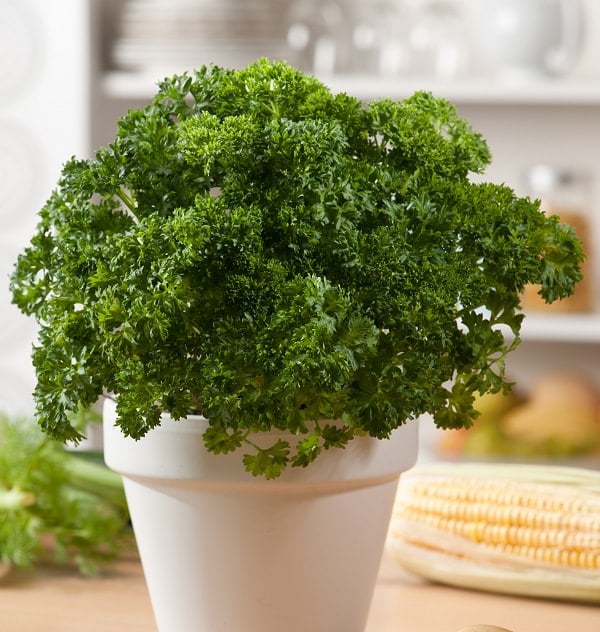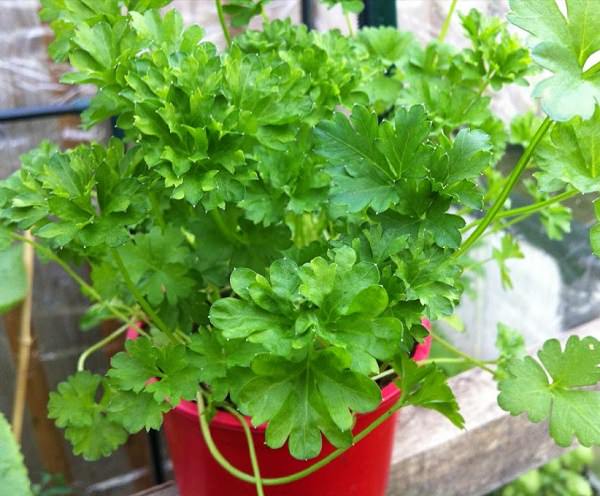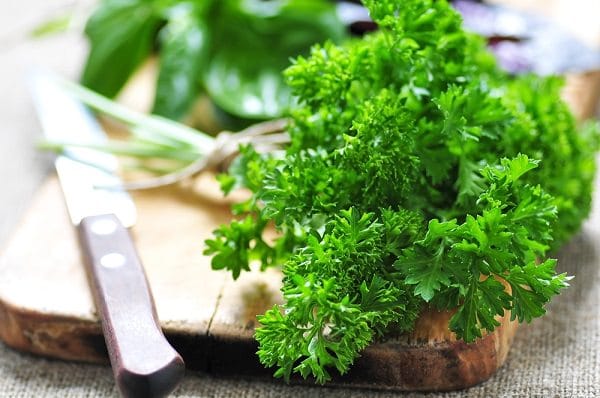Learn how to grow parsley in containers. Growing parsley in pots and its care is easy if you know the basic requirements!

Planting Time
Start planting parsley seeds indoors in the early spring when you start to feel the warmth in the air, usually 6-10 weeks before the last expected frost date. You can always plant this herb late as overwintering parsley is not difficult.
If you’re living in a hot climate (i.e., USDA Zones–10-11), start growing parsley after the end of the summer in fall (autumn) and winter, when the weather starts to cool down.
Growing Parsley from Seeds
Parsley seeds are notorious for their low and slow germination rate. They can take up to 6 weeks to germinate and sometimes more. So expect 3-5 weeks to see baby plants coming out. For quicker germination, soak seeds overnight.
It’s better to sow the seeds directly 1/4 – 1/8 inch deep in the desired containers as it doesn’t like much being transplanted. Thin the seedlings as they emerge and become 2 – 3 inches tall. The optimum germination temperature is between 60 – 80 F (15 – 27 C).
You can also propagate parsley from cuttings. For this, cut a 4 to 5 inches long stem with a few leaves on top, and plant it an inch deep in the pot. Maintain the moisture and keep the cutting in a shady spot that receives indirect light. Wait for a couple of weeks for the emergence of roots.
Parsley Types you Can Grow
There are three types of parsley used commonly in the kitchen–Flat Leaf or Italian Parsley, Curly Leaf Parsley, and Hamburg Parsley.
- Flat Leaf Parsley–This variety has a more vibrant, stronger, and sweeter flavor than any other type of parsley, and that’s why it’s used more in cooking. It grows a little taller and lanky and needs a wider pot to sprawl out than the curly leaf parsley. Also, the flat-leaf parsley is more heat tolerant.
- Curly Leaf Parsley–Curly leaf parsley is sweet and has a soft flavor. It is used mainly for garnishing and in salads. It is smaller in size, looks ornamental, and more controlled in growth, unlike the first one.
- Hamburg Parsley–A lesser-known parsley variety, grown for its swollen, edible, parsnip-flavored roots that can be used as a vegetable, while the upper part (leaves) can be used like flat-leaf parsley. Growing it is similar to other parsley varieties.
Choosing a Pot
Parsley is a biennial herb but also grown as an annual. If growing parsley as an annual, you can choose a small pot about 6-8 inches deep minimum. For growing parsley as a biennial crop, choose a rather large pot, at least 10 inches deep and wide similarly or more. You can grow one or two plants in such a pot.
Requirements for Growing Parsley in Pots
Position
For growing parsley in pots, choose a sunny or partially shaded location if you live in a cool or moderately warm climate.
If you live in a hot climate, keep the plant in a spot that receives full to partial sun but shade in the afternoon.
Soil
Use quality potting soil that is well-drained, loamy, and rich in organic matter. To enrich the growing medium, you can add one part of aged manure or compost for every two parts of potting soil.
Watering
Water parsley regularly and evenly to keep the soil slightly moist but not overly wet all the time. Never allow the soil to dry out completely and avoid overwatering to prevent rot!
Fertilizing
Applying fertilizer is not necessary if your soil is rich in organic matter. Adding aged manure or compost is enough. However, you can use half-strength balanced liquid fertilizer once in 3-4 weeks if your plant is not doing well.
Parsley Plant Care
Deadheading and Pruning
Remove the flower stalks if they appear to promote foliage growth. Also, pick the dead, yellowed, and faded leaves from time to time to keep your herb in shape.
Pests and Diseases
Leaf spot and rot are one of the most common diseases. You can save your parsley plant from root rot and crown rot by avoiding the waterlogged soil. Parsley worms, aphids, spider mites, and cutworms can affect this herb mostly, so keep an eye on them.
Growing Parsley Year Round
Growing parsley indoors is a way to have it year-round. By this, you can overwinter this culinary herb. It’s easy! The plant will survive at your average room temperature, and you’ll be able to harvest some leaves in winter if you keep the pot on a window that receives a few hours of direct sunlight daily.
Ensure the indoor temperature remains warm in winter, above 50 F (10 C), and leaves are not touching the frosty windowpane, or this may damage the plant.
In a Warm Climate
In hotter areas (USDA Zone 10, 11), you can save your parsley plant from dying in summer. Just keep it in a cool and shady but bright spot where it receives only 3 to 5 hours of morning sunlight daily.
These measures are important because the parsley plant hates the hot and humid weather and prefers a temperature below 90 F (33 C). Also, water your parsley generously in the summer!
Harvesting
Harvest parsley leaves when you need them. You can start harvesting parsley 2-3 months after planting. Wait until the stems are divided into three sections. Instead of only picking the leaves from the top, cut the entire stem carefully from the base as parsley stems are also edible and tasty.
Do this from the outer portion and let the inner part grow. Here’s a helpful article on Harvesting Parsley on Wikihow to see.






Great Tips!
Hi
My planted parsley’s leaf turned yellow. is there any solution for this problem?
Thank you for posting.I just planted two plants in a big pot and so glad that they look like yours!
My parsley has three stalks growing in the center of the plant with long slender leaves. What is it??